Harrier
Canis lupus
Harriers used to be called hare hounds as they were originally bred to hunt hares.
Advertisement
Harrier Scientific Classification
- Kingdom
- Animalia
- Phylum
- Chordata
- Class
- Mammalia
- Order
- Carnivora
- Family
- Canidae
- Genus
- Canis
- Scientific Name
- Canis lupus
Read our Complete Guide to Classification of Animals.
Harrier Conservation Status
Harrier Facts
- Fun Fact
- Harriers used to be called hare hounds as they were originally bred to hunt hares.
- Diet
- Omnivore
- Common Name
- Harrier
Harrier as a Pet:
- General Health
- Energy Level
- Shedability
- Trainability
- Intelligence
- Tendency to Chew
- Size
- Family and kid friendliness
- Yappiness / Barking
- Moderate
- Separation Anxiety
- Low
- Preferred Temperature
- Average climate
- Exercise Needs
- High
- Friendly With Other Dogs
- High
- Pure bred cost to own
- $1,500 to $2,500
- Dog group
- Sporting
- Male weight
- 45-60 lbs
- Female weight
- 45-60 lbs
This post may contain affiliate links to our partners like Chewy, Amazon, and others. Purchasing through these helps us further the A-Z Animals mission to educate about the world's species.
View all of the Harrier images!
These dogs are called hare hounds as they were originally bred to hunt hares. Since then, they have become the ideal first-time dog for families everywhere.
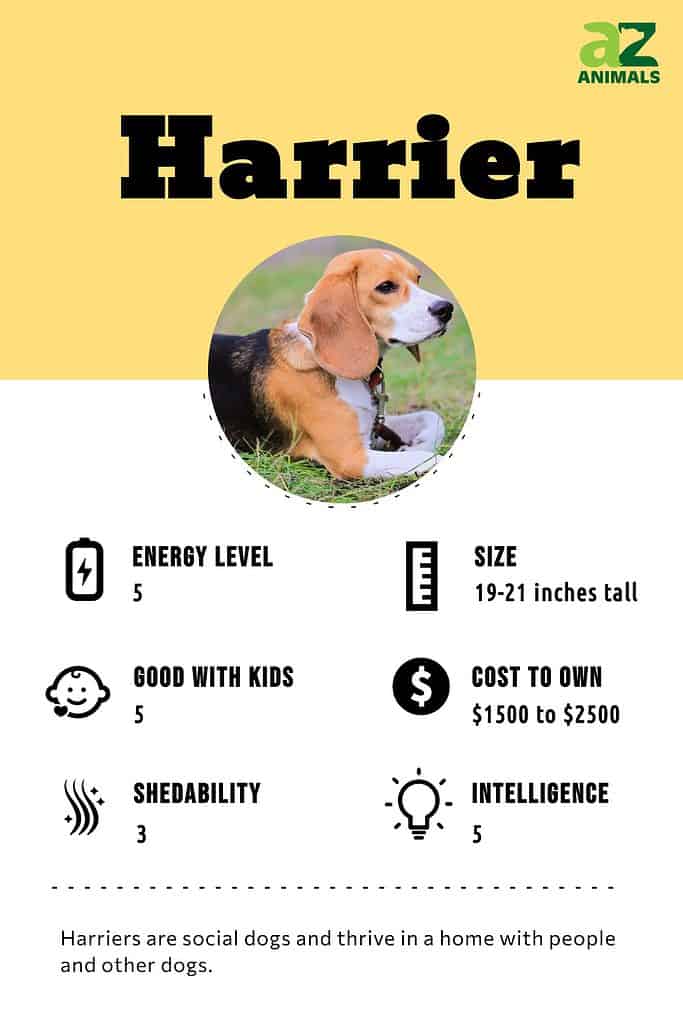
Harriers are affectionate, fun-loving and sweet, which is another reason that people love them as much as the Beagle or the English Foxhound. Even though the breeds are incredibly different, their coats are strikingly similar. Like the Beagle, the Harrier shares the same trait of their coats changing colors as they age.
See all of our expert product reviews.
With their friendly nature as pack hounds, these dogs can be highly energetic. They love to run, making them ideal companions for individuals that like to jog and engage in different sports. Keeping a leash on them while in public areas is crucial as they also like to freely follow any scent that might attract their attention.
Breed History
The first pack of the harriers is believed to have been bred in England in the 1200s to chase hares. However, there are conflicting stories about this breed’s origins. In one account, they were crosses of the Bloodhound, the Talbot Hound and the Basset Hound, yet in another the Harrier was a mix of the English Foxhound, the Terrier and the Greyhound.
Known to have originated in England, this breed was only recognized by the Kennel Club in January of 2020. Extremely popular in Ireland, they are the most commonly used dog in hunts. The Harrier was brought by settlers to the United States in the early 1800s and although this breed was recognized by the American Kennel Club in 1885, they are still rare to find in the United States of America.
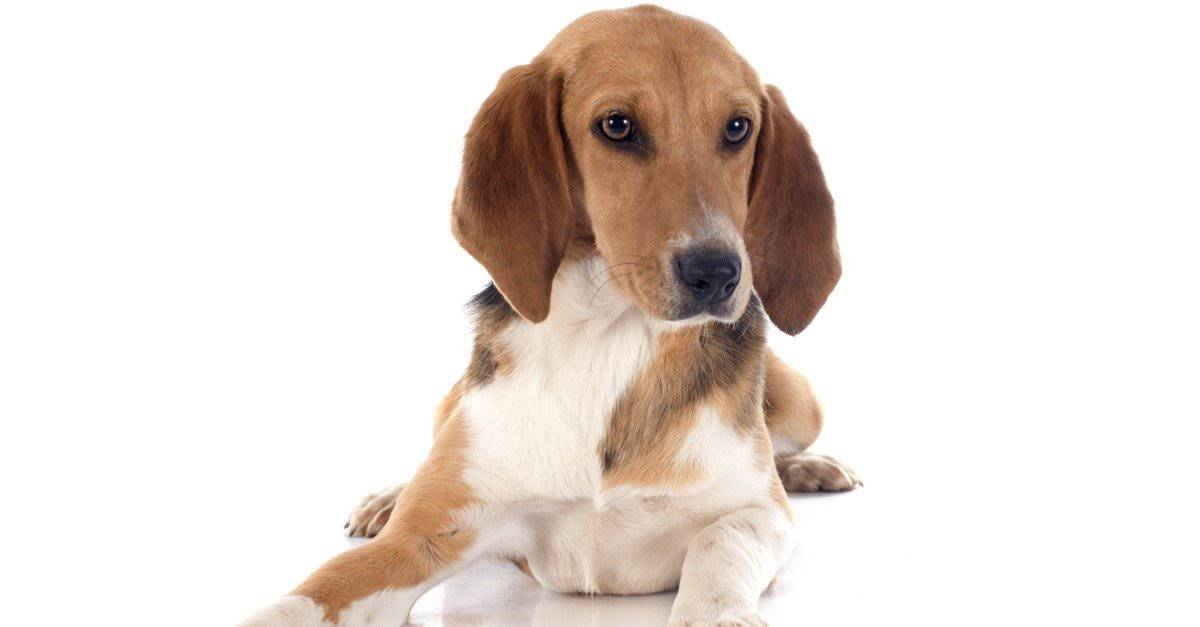
Harriers are rare to find in the United States.
©cynoclub/Shutterstock.com
Health and Entertainment for your Harrier
See all of our expert product reviews.
Harrier vs. Beagle
Though the Harrier and the Beagle look similar, they are very different. While they both originate in Europe, the harrier is commonly double the weight of the beagle, despite the fact they are only 3-4 inches longer. Both animals have white, black, tan, and red in their coats, though Harriers have some yellow hues as well. While the Beagle has a dense coat, the Harrier has a thicker and shinier coat.
With similar personalities, families that want a quieter dog should adopt the harrier; the beagle can be quite vocal and noisy. Due to the need to train and acclimate the dogs to their surroundings, harriers are thought to be a better fit for individuals that have not owned a dog before. Beagles require a bit more experience to take care of properly.
3 Pros and Cons of Owning a Harrier
Before owning any pet, you would always need to establish whether or not they are right for you. Consider these pros and cons to determine if the Harrier is the right dog for your family.
| Pros! | Cons! |
|---|---|
| Affectionate: This dog breed is very affectionate and is loving towards the owner’s family. | High exercise needs: Harriers have a very high need to exercise, which means that their owners will need to bring them out frequently to prevent destructiveness and boredom. |
| Good with kids: If you are looking for an infant-friendly pet, harriers are extremely gentle. | Not good with non-canine animals: These pups are usually not good with any other non-dog animal that you might have which would ultimately lead to compatibility issues |
| Running companion: These dogs are very athletic and can make great running and jogging companions. | Stubborn: Harriers can be very stubborn which could turn out to be hard on the owner eventually. |
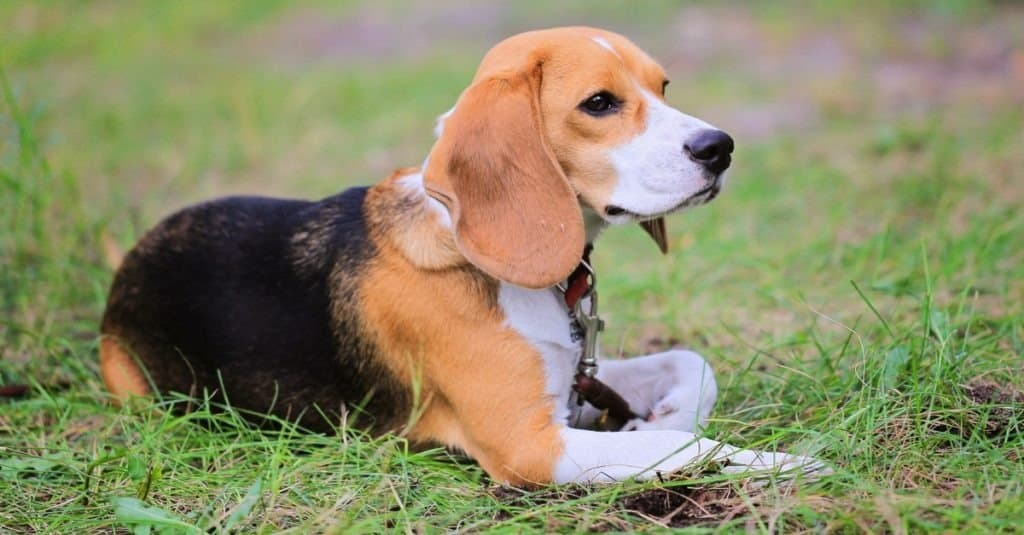
©Viktor Prymachenko/Shutterstock.com
Size and Weight
The Harrier is a medium-sized dog, and their size is about the same for both males and females. This dog is about 19 to 21 inches in length, and weighing about 45 to 60 pounds.
| Height (Male) | 19-21 inches tall |
| Height (Female) | 19-21 inches tall |
| Weight (male) | 45-60 lbs., fully grown |
| Weight (female) | 45-60 lbs., fully grown |
Common Health Issues
Like all other living creatures, harriers are generally healthy but still have some issues that could be potential concerns with regard to their health. Hip dysplasia is incredibly painful, due to the misalignment of the hip bone in the socket.
There are a few genetic diseases that impact the harrier, including hypothyroidism. Left untreated, it can cause weight issues and other hormonal concerns. However, this issue can be uncommon. These dogs sometimes face eye diseases, but the cases are minimal.
Some of the common health problems that harriers are prone to include:
- Hip Dysplasia
- Eye diseases
- Genetic disorders
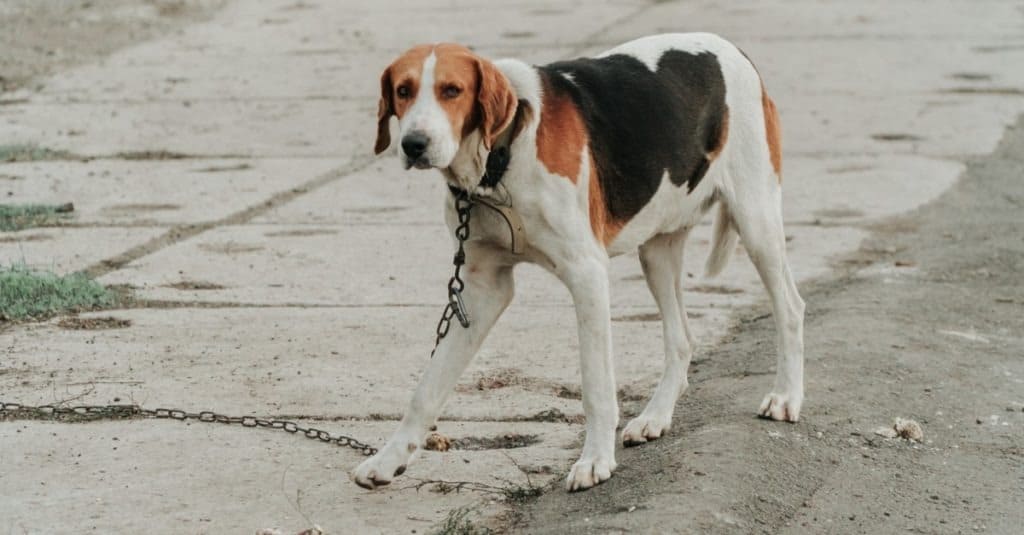
The Harrier is prone to hip dysplasia.
©evaleenage/Shutterstock.com
Temperament
Disposition-wise, the harriers are known to be very energetic and are often very playful. They love to be around people and other dogs but they might not get along too well with other pets that you might have. They do not feel warm towards any other animal and see cats and other small pets as potential prey to be chased and caught hold of.
These dogs are known to be great with children and are intelligent and independent. Harriers often make their own decisions.
How to Take Care of Harriers
For you to be able to know how to effectively take care of harriers, it is essential that you know what needs to be done to extend proper care to them. Here are a few tips to ensure that any harrier adoption is a good experience.
The Best Dog Food for Harriers
Harriers should be fed premium dog food, including both wet and dry textures. If you want to feed them a fresh diet, they can safely consume bone-out chicken, turkey, and beef, as long as it is cooked without oils and has minimal fat. They’ll also willingly consume salmon and duck, if available.
Puppies need to be fed in a similar way, though their protein intake will increase as they get older. You would also need to check for any allergies and avoid feeding your harrier dog foods that could harm them.
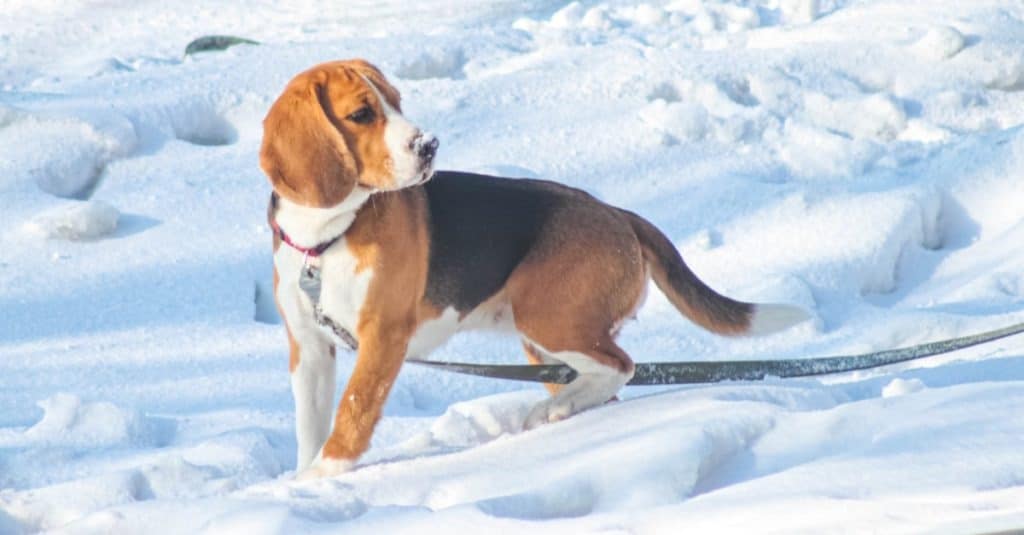
This is a very energetic breed prone to boredom and require mental and physical stimulation.
©MargaPl/Shutterstock.com
At A-Z Animals, we find that the best dog food for Harriers is Stella & Chewy’s Wild Red Classic Kibble Dry Dog Food.
The chicken, duck, and turkey in this formula account for 81% of the high protein content. With wholesome grains and absolutely no potatoes, lentils, peas, artificial colors, or preservatives, this food is rich in glucosamine for joint support. And the taurine nourishes Harriers’ eyes for clear vision.
See if your dog thrives eating Stella and Chewy’s Wild Red Classic Kibble, available on Chewy or Amazon.
- Packed full of protein with beef, pork, and lamb.
- 81% of its yummy protein is from actual animal sources!
- Recipe uses “whole prey” ingredients, including muscle meat, organ meat, and cartilage.
- Doesn’t contain fillers, artificial colors, artificial flavors, or preservatives.
Maintenance and Grooming
Harriers have short and dense coats, decorated in red, tan, brown, yellow, and white. You would need to brush their coat once every week in order to remove any dead hair that they might have. The shedding in these dogs is usually moderate, but regular grooming helps exponentially.
Make sure to bathe the harrier if they become dirty, trim their nails, and brush their teeth to ensure their health. They’ll also need to have their ears cleaned out, but all of these types of grooming can be done with a professional instead.
Training
Harriers are stubborn at times, which could cause problems while training them. To ensure that this pup is kind to other animals, expose them when they are young to prevent conflict. Plus, early exposure to new people will reduce their anxiety and defensiveness, helping them to get used to the people that often visit their family.

Expose puppies to other animals while young to avoid conflict.
©Joachim Bago/Shutterstock.com
Exercise
Harriers were originally bred for hunting purposes and, as such, need a lot of exercise on a daily basis. They can spend hours chasing after potential prey.
A lack of a high amount of exercise daily could turn the dog’s behavior destructive. These dogs enjoy jogging, long walks as well as several other outdoor activities and games. It keeps them in check, and they are usually found happy after these exercises.
If their exercise requirements are met, the dogs can be very adaptable to any kind of environment. Keep them on a leash when they are in a heavy traffic zone as they can easily wander off if they find a desirable scent.
Puppies
Finding a purebred harrier puppy can be quite a task because they are very rare to find. The needs of the puppies are different from that of an adult. You need to give harrier puppies adequate amounts of proteins which would be different from the protein requirements that an adult Harrier dog has.

Harriers are tolerant of the excited energy of children.
©Smcmilla – Public Domain
Harriers and Children
Known to be great with children, harriers are tolerant of the excited and playful nature of kids, joining in their antics energetically. If you want a pup to keep in a big family, the harrier would be a great choice to make. However, you would still need to supervise them when they are around children.
Dogs Similar to Harriers
Since Harriers aren’t always the right fit for someone, here are a few other breeds that could blend well in the family.
- Bloodhounds: These are large dogs that were originally bred in France. They are also helpful companions while hunting.
- American Foxhound: American foxhounds were originally bred in the 1700s. These dogs are very muscular and have great stamina.
- Beagles: This breed is both energetic and friendly. They are very loyal too. They make great family pets.
Famous Harriers
There is little known about any famous harriers in history or cinema. Since the dog has only been recognized in certain parts of the world for the last few decades, it is possible that they’ve been mislabeled as beagles or foxhounds in the past.
Popular Names for Harriers
Here are some of the popular names for harriers:
- Molly
- Tasha
- Sammy
- Cleo
- Baby
Harrier FAQs (Frequently Asked Questions)
Are Harriers herbivores, carnivores, or omnivores?
Harriers are Omnivores, meaning they eat both plants and other animals.
What Kingdom do Harriers belong to?
Harriers belong to the Kingdom Animalia.
What class do Harriers belong to?
Harriers belong to the class Mammalia.
What phylum to Harriers belong to?
Harriers belong to the phylum Chordata.
What family do Harriers belong to?
Harriers belong to the family Canidae.
What order do Harriers belong to?
Harriers belong to the order Carnivora.
What type of covering do Harriers have?
Harriers are covered in hair.
What genus do Harriers belong to?
Harriers belong to the genus Canis.
What is an interesting fact about Harriers?
Harriers are cheerful, tolerant, and sweet-tempered!
What is the scientific name for the Harrier?
The scientific name for the Harrier is Canis lupus.
What is the lifespan of a Harrier?
The lifespan of the Harrier is usually 10 to 12 years.
How much does harrier cost to own?
Harriers can have a price of anywhere between $1,500 to $2,500 to adopt a purebred. You could expect an additional price of $2,000 for the maintenance and grooming of the harriers each year.
Is the harrier good with kids?
Yes, harriers are great with kids. They are affectionate and playful and energetic around them.
What's the difference between a harrier dog vs. a beagle?
Harriers are usually larger than beagles. Beagles also have a denser coat while harriers’ coats have thicker and shinier.
What is a harrier?
A harrier is a multi-colored dog that is friendly with children and incredibly intelligent, though it is sometimes mistaken for a beagle. Interestingly, a harrier is also a term to describe someone who gets involved in attacks on others or their land.
Do Harrier dogs make good pets?
Yes, Harriers make great pets. They are affectionate and loving. They are also very playful.
How big do Harrier dogs get?
Harriers are usually 19 to 21 inches in size.
Thank you for reading! Have some feedback for us? Contact the AZ Animals editorial team.
Sources
- Vetstreet, Available here: http://www.vetstreet.com/dogs/harrier
- American Kennel Club, Available here: https://www.akc.org/expert-advice/lifestyle/7-things-you-didnt-know-about-the-harrier/
- The Happy Puppy Site, Available here: https://thehappypuppysite.com/harrier-dog/
- Dogtime, Available here: https://dogtime.com/dog-breeds/harrier#/slide/1
- Paw Diet, Available here: https://www.pawdiet.com/breeds/best-dog-food-for-harrier/


















